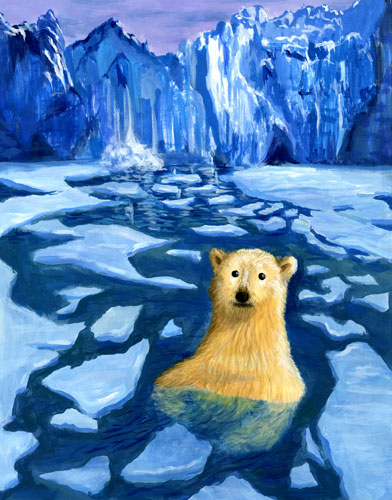 Hazy sunshine this afternoon, and windy, too, here on California’s north coast — there’s also a bit nip in the breeze.
Hazy sunshine this afternoon, and windy, too, here on California’s north coast — there’s also a bit nip in the breeze.
And off our shores, a changing-warming environment has also led to the arrival of marine life seeking cooler waters — most recent discovery, the Janthina janthina, the common purple snail.
Apparently part of an ongoing process, and as detailed yesterday at Lost Coast Outpost, the purple snail is an oddity:
‘But they are anything but common here – they’re normally found in the warmer waters of tropical and temperate seas, far from shore. They are very cool creatures that survive by creating “bubble rafts,” trapping air pockets and clinging together to maintain position on the ocean surface.’
(Illustration found here).
Odd, yet, but laced with a touch of that good, old ‘new normal’ after-effect — further from LoCO:
National Marine Fisheries Services Researcher and HSU fish prof Eric P. Bjorkstedt, Ph.D, noted the odd sighting could very well be part of a larger trend.
“They’re normally offshore critters,” he said.
“We get some snails, but these are much different.”
The appearance of the Janthina is also consistent with the increased ocean temperatures offshore, Bjorkstedt continued, and is the latest in a list of warmer-water species been seen near the North Coast.
The ‘trend‘ is the ripple off climate change. And although a lot of shit isn’t directly ‘caused‘ by global warming, you can bet your bottom dollar, that same shit has been altered, shifted, exacerbated at minimum, or otherwise, fucked-with by a heating-up environment.
In that context, and the warming of the seas, is the “warm blob” of water extending in a 300-foot layer off the coast of the Pacific US, and more-oddity to the plot, the patch of water could be influencing the weird weather we’ve been seeing this winter across the country — interesting details via Phys.org:
A long-lived patch of warm water off the West Coast, about 1 to 4 degrees Celsius (2 to 7 degrees Fahrenheit) above normal, is part of what’s wreaking much of this mayhem, according to two University of Washington papers to appear in Geophysical Research Letters, a journal of the American Geophysical Union.
“In the fall of 2013 and early 2014 we started to notice a big, almost circular mass of water that just didn’t cool off as much as it usually did, so by spring of 2014 it was warmer than we had ever seen it for that time of year,” said Nick Bond, a climate scientist at the UW-based Joint Institute for the Study of the Atmosphere and Ocean, a joint research center of the UW and the U.S. National Oceanic and Atmospheric Administration.
…
The authors look at how the blob is affecting West Coast marine life.
They find fish sightings in unusual places, supporting recent reports that West Coast marine ecosystems are suffering and the food web is being disrupted by warm, less nutrient-rich Pacific Ocean water.
…
That pattern, which also causes the blob, seems to have become stronger since about 1980 and lately has elbowed out the Pacific Decadal Oscillation to become second only to El Niño in its influence on global weather patterns.
…
Bond says that although the blob does not seem to be caused by climate change, it has many of the same effects for West Coast weather.
“This is a taste of what the ocean will be like in future decades,” Bond said.
“It wasn’t caused by global warming, but it’s producing conditions that we think are going to be more common with global warming.”
Another example of global-warming blowback loop-and-circle, consequences a far-reaching change in our climate creates as if in a ripple effect, and seemingly starting to cascade out of understanding.
And related to oceans, a new study released yesterday by the University of Edinburgh and some pre-history to update the nowadays (via ScienceDaily):
Changes to the Earth’s oceans, caused by extreme volcanic activity, triggered the greatest extinction of all time, a study suggests. The amount of carbon added to the atmosphere that triggered the mass extinction was probably greater than today’s fossil fuel reserves, the team says.
However, the carbon was released at a rate similar to modern emissions.
This fast rate of release was a critical factor driving ocean acidification, researchers say.
…
Dr Matthew Clarkson, of the University of Edinburgh’s School of GeoSciences, who co-ordinated the study, said: “Scientists have long suspected that an ocean acidification event occurred during the greatest mass extinction of all time, but direct evidence has been lacking until now.
“This is a worrying finding, considering that we can already see an increase in ocean acidity today that is the result of human carbon emissions.”
And in a similar note, the end of that LoCO piece above, tales telling:
How much of this can be assigned to climate change?
“You never want to attribute a single event to climate change,” Bjorkstedt noted.
“But one prediction has been that when Arctic sea ice is reduced, this is the kind of change that would happen.”
Given today’s earlier report, we had to ask – as a scientist, does Bjorkstedt believe in climate change?
“Of course!” he said.
“And, as a scientist, it doesn’t matter if I believe in it — it’s happening.”
About the very-size of it — as noted, that ‘report‘ was of a new survey about where you lived influencing how you felt about climate change, the actual reality, the politics and all (I posted Wednesday on the study) — only 53 percent of Humboldt County adults, where I reside, think global warming is real and caused by humans.
An ocean of evidence may not be enough, even if ‘it’s happening.’